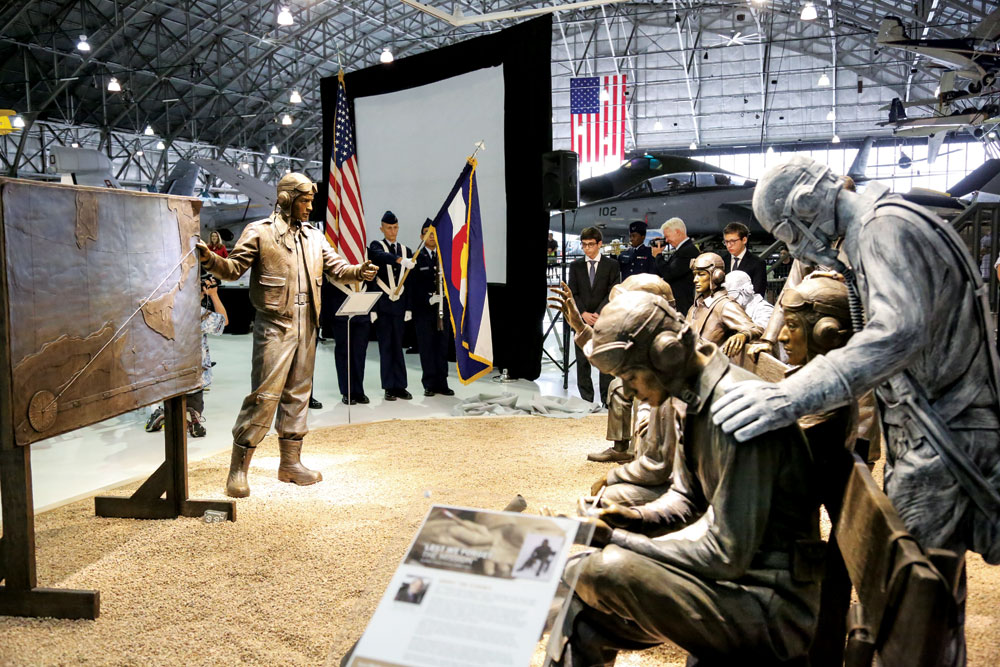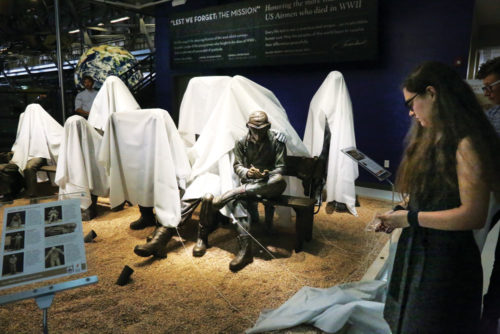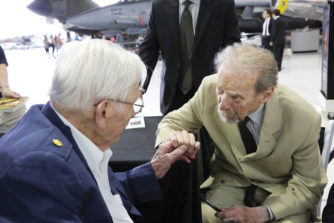
Guests view the scene in the sculpture that was repeated many times during the war. Pilots were shown their mission using a map, a string and a compass. The spirits of fallen comrades are depicted behind the airmen.
Fredric Arnold was 19 years old when Pearl Harbor was bombed. He had never thought about being in the military—he was an artist. Three months later he was in the Army Air Corps and signed on to be a pilot. He was one of 14 airmen sent to Africa where the young, barely trained American pilots faced experienced German pilots. Six months later only two of the 14 were alive.
Arnold and the other pilots were told they needed to fly 25 missions before going home—then the requirement was upped to 50 missions. “I never thought I’d make it home,” he says.

The sculpture was unveiled during a ceremony on Aug. 6 by the artist’s grandchildren.
But despite being shot down and captured, he escaped from behind enemy lines and completed 50 missions.
“When the war was over, I wanted to forget everything. I didn’t want to look in the mirror and see killer,” says Arnold in a video about his sculpture project.
Arnold managed to resume his old life as an artist, and he got married and had a family. Years later, in 1998 he got a call that the other remaining survivor was dying. Arnold visited him in the hospital and said good-by.
His comrade from the war reminded him of the solemn vow the two of them had made when they were the only two survivors of the 14 pilots who had gone to Africa. The last man standing would undertake to honor those twelve comrades lost in the war. “It’s up to you,” his friend said. Arnold promised.
For the next few years Arnold pondered how he could honor his fallen comrades. Ultimately he came up with the idea to recreate the scene that had been repeated so many times during the war.

Lester (Bill) Zinser (left), a retired major who flew B-52s in World War II introduces himself to sculptor Fredric Arnold, now more than 90 years old, at the unveiling event at Wings Over the Rockies.
The squadron leader stands by a map. He stretches a string across the map from their base to the target. By referencing a compass and the range marks at the bottom of the map, he determines the outbound heading and distance to the target.
Arnold decided to create figures in the sculpture that were not specifically the individuals who had died, but who represent a “composite archetype from his memory of many individuals he encountered during the war. Each carries a nickname that captures an essential message about that archetype.
The squadron leader gives the men their orders.
“Teenager” represents the many, many young men who signed up after the bombing of Pearl Harbor.

Attendees view a video about the sculptor’s story.
The five spirits are shown fading away behind the airmen. Their faces are covered by goggles and masks. They are unrecognizable, symbolizing the loss of their identity—war robbed the world of ever knowing them.
Lest We Forget: The Mission stemmed from Arnold’s deep gratitude to the twelve original members of the group who didn’t survive to live their lives in peace.
Although the sculpture began as a testament to the twelve pilots in the squadron, the scope of the work grew. The sculpture with the 12 figures is dedicated to the memory of the more than 88,000 U.S. aviators who gave their lives during WWII.
The sculpture is on display at Wings Over the Rockies Museum in Lowry at 7711 East Academy Blvd. For more information visit LestWeForgetSculpture.org or WingsMuseum.org.




Lester is my father, Anne is correct about the B52. My father (Lester Zinser) flew the B24, B25 and B29’s, the B29 being his favorite. He went on to fly for the National center for atmospheric research (NCAR) and flew many different planes, but loved the queenair. He also was Ham’s handler in the space program as well as many other accomplishments in his life.
Your caption on page 39 of the September 2016 issue under the photo of Lester and Frederic states:
“Zinser…who flew B-52s in WWII”….
Thought you might be interested to know that the first operational prototype of the B52 didn’t take flight until April of 1952 nearly seven years after the war ended. The Boeing B52 is an eight engine nuclear capable long range jet bomber built to counter the growing threat of Soviet nuclear technology which began to emerge in the late 1940s. There were no operational American jet aircraft of any kind to see action in either theater during the second world war.
The primary American four engine heavy bombers of WWII were the B17 Flying Fortress the B24 Liberator and the B29 Super Fortress
Other bombers in the inventory which were both twin engine were the B25 and the B26.
All of the above were powered by piston engines.
Thank you
Cliff A.
Thank you to Cliff A. for the additional information and clarification.